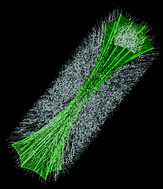Hierarchical pattern of microfibrils in a 3D fluorapatite–gelatine nanocomposite: simulation of a bio-related structure building process†
Abstract
The shape development of a biomimetic fluorapatite–gelatine nanocomposite on the μm scale is characterised by a fractal mechanism with the origin being intrinsically coded in a (central) elongated hexagonal-prismatic seed. The 3D superstructure of the seed is distinctively overlaid by a pattern consisting of gelatine microfibrils. The orientation of the microfibrils is assumed to be controlled by an intrinsic electrical field generated by the nanocomposite during development and growth of the seed. In order to confirm this assumption and to get more detailed information on orientational relations of the complex nanocomposite we simulated the pattern formation process up to the μm scale. The results from experimental studies and simulation results on an atomistic level support a model scenario wherein the elementary building blocks for the aggregation are represented by elongated hexagonal-prismatic objects (A-units), with the embedded collagen triple-helices in their centers. The interactions of the A-units are consequently modelled by three contributions: the crystal energy part (originating from the pair-wise interactions of the “


 Please wait while we load your content...
Please wait while we load your content...